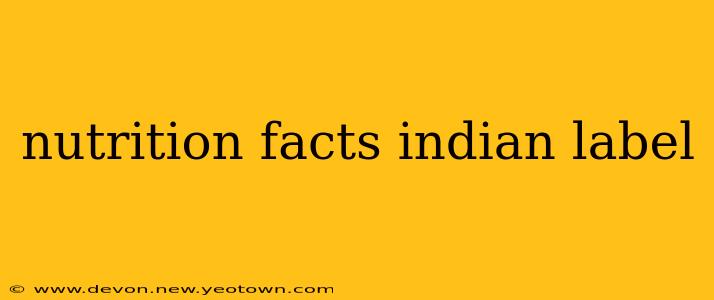India's diverse culinary landscape is a delicious adventure, but navigating nutrition labels can feel like cracking a code. Let's embark on a journey to decipher the information on Indian food packaging, making informed choices easier than ever. This isn't just about numbers; it's about understanding what those numbers mean for your health and well-being.
Imagine you're at your favorite Indian grocery store, surrounded by vibrant spices and enticing aromas. You pick up a package of your favorite namkeen or a jar of your go-to pickle. But before you toss it into your cart, a small, often overlooked panel catches your eye: the nutrition facts label. Understanding this label is your secret weapon to making healthy choices within the richness of Indian cuisine.
What Information Does the Indian Nutrition Facts Label Provide?
The Indian nutrition label, much like its international counterparts, aims to provide a snapshot of the nutritional content of the food product. Key components usually include:
- Serving Size: This tells you how much of the product constitutes one serving. Pay close attention to this, as the rest of the information is based on this serving size.
- Energy (Calories): The total energy content of the serving, vital for managing your daily caloric intake.
- Macronutrients: This section usually breaks down the amounts of carbohydrates, proteins, and fats per serving. Often, it further categorizes fats into saturated, unsaturated, and trans fats.
- Micronutrients: While not always exhaustive, labels often include information on crucial vitamins and minerals like Vitamin A, Vitamin C, Calcium, and Iron. The presence and quantity of these vary significantly depending on the product.
- Added Sugar: Many labels now explicitly list the amount of added sugar, allowing you to make conscious choices to minimize your sugar intake.
How to Read and Interpret the Nutrition Facts Label Effectively?
Let's look at a hypothetical label:
| Nutrient | Amount per serving | % Daily Value* |
|---|---|---|
| Energy (kcal) | 200 | 10% |
| Carbohydrates (g) | 30 | 15% |
| Sugars (g) | 10 | N/A |
| Protein (g) | 5 | 10% |
| Total Fat (g) | 10 | 15% |
| Saturated Fat (g) | 2 | 10% |
| Trans Fat (g) | 0 | N/A |
| Sodium (mg) | 200 | 10% |
*Percent Daily Values are based on a 2000 calorie diet. Your daily values may be higher or lower depending on your calorie needs.
This table shows that one serving of this particular food contains 200 calories, providing 10% of your daily recommended calorie intake (based on a 2000-calorie diet). Analyzing the other percentages similarly helps to assess how this single serving contributes to your daily needs or exceeds recommended limits. Remember, these percentages are guidelines and may not always perfectly reflect your specific dietary needs.
What are the common challenges in understanding Indian nutrition labels?
H2: Are there differences between Indian and other country's nutrition labels?
While the core information remains similar across countries, minor variations in presentation and the specific nutrients highlighted can exist. Some labels might emphasize traditional Indian dietary components like spices or focus more on particular nutrients relevant to the Indian context.
H2: How can I compare nutrition information across different brands?
Comparing labels is crucial for smart shopping. Focus on the "per serving" information to get an accurate picture. Check the serving size—identical amounts must be compared to draw accurate conclusions.
H2: What are the common pitfalls to avoid when reading Indian nutrition labels?
Don't get swayed by marketing claims. Always cross-reference the claims with the actual nutrient data on the label. Pay attention to the serving size; it's the bedrock of interpreting the nutritional information. Avoid solely relying on a single nutrient. Aim for a balanced nutritional profile.
Conclusion:
Navigating the Indian nutrition facts label might seem initially daunting, but with practice, it becomes a powerful tool in your culinary journey. By understanding its components and using it wisely, you can make informed choices that support both your taste buds and your overall health. So, the next time you're shopping for your favorite Indian treats, remember – you're not just buying food; you're investing in your well-being. Happy shopping!

